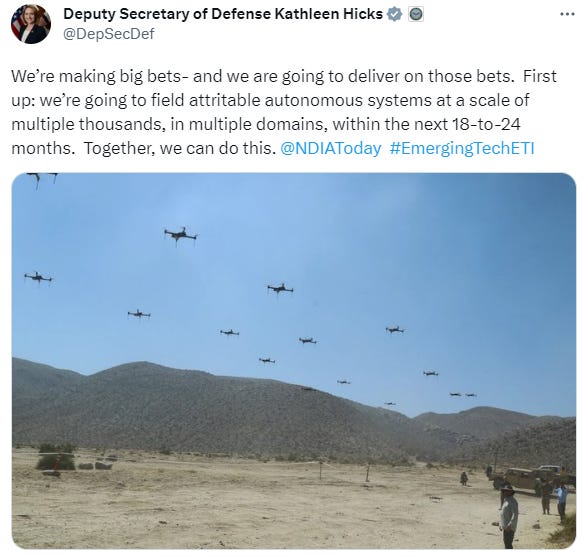Sorry, the Swarm will not Save Us
72-hour transformational offset wishcasting
As the Russo-Ukrainian War reaches its 20th month, I hope everyone has been sufficiently sobered up to stand firmly against those promoting the “72-hour War” or spin an attractive story about some transformational secret sauce that provides an “easy button” for those tasked to do the very hard work of preparing a nation for war should, and if, it were to come.
See the Battle of Hostomel if you need a recent example of where buying this wishcasting can get you.
There is a reason we have continually railed against this Potomac Flotilla mindset for the better part of two decades here - it is the self-delusion of faculty lounge theories running up against the Gods of the Military Copybook Headings reality what we have thousands of years of experience to reference.
We are not smarter than previous generations. There is no secret weapon or war winning technology - or magic beans - that will allow us to skip past the hard work of a viable strategy backed up by a properly resourced industrial capacity to build, maintain, deploy, and sustain a fighting force on the other side of the Pacific for years if needed.
Not 24-hours. Not 72-hours. Think 72-weeks to 72-months and you have your mind right.
As is clear as day in yesterday’s post, I am pro-drone, experimentation, and advancement - but the below does not smell like that. This is something else.
Autonomous systems are a great evolved tool, which the Russo-Ukrainian War continues to demonstrate their utility - capabilities and limitations. However, here in August 2023 saying that by February 2025 or so something magical is going to happen because we will have magic beans is at best just setting the stage for another cycle of overpromising and underdelivering, at worst giving us an excuse to take the eye off the ball for what we need the senior leaders of our DOD focused on;
Industrial capacity.
Magazine inventory.
Expanded maintenance facilities.
Strategic sealift and airlift.
Mobile and deployable maintenance and sustainment capability.
That is just the top-5. More drones? Sure. That is as important as more 155mm rounds and a few hundred more - not make that a few thousand more - long range precision strike missiles, cruise, ballistic, 220, 221 - whatever it takes.
China’s most important asset in potential war with the United States is “mass,” says Deputy Defense Secretary Kathleen Hicks: “More ships. More missiles. More people.”
To counter that advantage, the Defense Department will launch an initiative called Replicator to create cheap drones across the air, sea, and land in the “multiple thousands” within the next two years.
Cheap drones, of the type Ukraine has deployed to great effect against Russia, can be produced close to the battlefield at much lower cost than typical Defense Department weapons.
“They can be used consistent with our principles of mission command, where we empower the lowest-possible echelons to innovate and succeed in battle. And they can serve as resilient, distributed systems, even if bandwidth is limited, intermittent, degraded, or denied.” Hicks said in remarks at the NDIA conference in Washington, D.C.
The drones also get at the main challenge the United States military would face in the Pacific in a fight with China: too many targets across a massive geographic space.
How many targets does that mean? “Here's a metric for me: 1,000 targets for 24 hours,” said Adm. John Aquilino, head of U.S. Pacific Command.
“To counter that advantage…” - let’s not get over our skis here people.
I would encourage everyone to listen to the July 24th Dmitri Alperovitch podcast “Geopolitics Decanted” titled, How Drones Are Changing the Nature of Warfare in Ukraine for a sober review of the capabilities and limitations such systems bring to the real world.
We do no one any good allowing free run towards the national security version of the prosperity gospel, a branch of the transformationalist cult, and their “name it and claim it” attitude towards solving hard problems.
From LCS to DDG-1000, to optimal manning, to six-sigma supply nightmares, to 100-hour workweeks, to 72-hour war CONOPS, to the “Deter by Punishment,” to “1,000 ship navy,” to the offset of this POM cycle, to counter-historical excuses for … again … not doing the hard work that takes so long to bear fruit that someone else will get credit for it.
Every time we have our top leaders - smart hard working professionals with the best intentions - step up to sound more like this guy - the worse we will all be.
It degrades them and endangers everyone.
We don’t need to sell the utility of small drones being used down to the lowest levels of responsibility - it is demonstrated every day.
What we do need sold is Congress’s need to fund a revitalization of our defense industrial capacity and a focus on the naval and aerospace forces that will do most of the fighting in any expected war west of the International Dateline.
Supported by swarms of drones of all shapes and sizes.





"We are not smarter than previous generations. There is no secret weapon or war winning technology - or magic beans - that will allow us to skip past the hard work of a viable strategy backed up by a properly resourced industrial capacity to build, maintain, deploy, and sustain a fighting force on the other side of the Pacific for years if needed."
Deja vu all over again.
Studying history is depressing. And very few of the cool kids bother. But man, do they have ideas!
How about OSD/JCS first determine an actual joint strategy and war termination terms requirement for a conflict with the PRC before getting into the tactical weeds on drones? Force in the Indo-Pacific need more ordnance in general to start and short-range drones would not be in the first category of requirements.